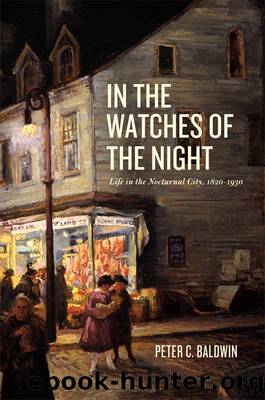In the Watches of the Night by Peter C. Baldwin

Author:Peter C. Baldwin
Language: eng
Format: epub
Publisher: University of Chicago Press
Published: 2012-01-15T00:00:00+00:00
CHAPTER 9
Night Life in the Electric City
Until the 1880s, gas lighting gave the nocturnal city a landscape of light and shadow. Brightly lit thoroughfares, with glowing shop windows and illuminated signs, intersected dark side streets that led through the slums. Public lamps were too weak and too few to illuminate a whole block. Unless supplemented by privately owned lighting on businesses or homes, gas lamps left dark gaps where faces could not be recognized and shapes were only dimly discerned. Uneven lighting reflected and in some ways encouraged the human qualities of the night city: the dramatic contrasts of safety and danger, wealth and poverty, work and leisure, virtue and vice.
Electricity produced a different visual experience of urban night. Far brighter than gas, electric streetlights could fill a city block with light instead of just the circle around the lamppost. Shadows shrank back, revealing facial expressions and house numbers. By the late 1920s, a wash of electric brightness had covered the old chiaroscuro landscape of the gaslit city. Major streets could now be seen at night with a detailed clarity once possible only in gaslit rooms. The glow even in dimmer side streets was usually sufficient to make faces recognizable. The big city might still be an anonymous world of strangers, but not because of darkness.
In other ways, one could argue that electricity merely updated the qualities of the gaslit city. Disparities in lighting persisted. Brightness remained the marker of conspicuous consumption. Nighttime entertainment still concentrated in the most brilliantly illuminated streets, and incandescent displays in shop windows gave an aura of luxury to retailing districts. Chicagoâs Clark Street at night, observed a newspaper reporter in 1892, was âresplendent with flashing lights and gaily dressed promenaders from all quarters of the city. Here are grand hotels, fine theaters, variety shows, dime museums, shooting galleries, railroad ticket offices, dance-halls, and ready made clothing stores, all ablaze with light and filled with pleasure seeking humanity.â Ordinary citizens rubbed shoulders with gamblers and prostitutes inside glittering billiard parlors and âgin palaces.â1 All this seemed to echo the descriptions of gaslit cities fifty years before.
Download
This site does not store any files on its server. We only index and link to content provided by other sites. Please contact the content providers to delete copyright contents if any and email us, we'll remove relevant links or contents immediately.
| Automotive | Engineering |
| Transportation |
Machine Learning at Scale with H2O by Gregory Keys | David Whiting(4262)
Never by Ken Follett(3885)
Urban Outlaw by Magnus Walker(3367)
OPNsense Beginner to Professional by Julio Cesar Bueno de Camargo(3262)
Sapiens and Homo Deus by Yuval Noah Harari(3034)
Will by Will Smith(2875)
A Short History of Nearly Everything by Bryson Bill(2666)
Hooked: A Dark, Contemporary Romance (Never After Series) by Emily McIntire(2528)
Rationality by Steven Pinker(2331)
Borders by unknow(2283)
The Becoming by Nora Roberts(2158)
Holy Bible (NIV) by Zondervan(2101)
HBR's 10 Must Reads 2022 by Harvard Business Review(1822)
A Short History of War by Jeremy Black(1819)
The One Percenter Encyclopedia by Bill Hayes(1812)
Freedom by Sonny Barger(1786)
Go Tell the Bees That I Am Gone by Diana Gabaldon(1733)
Five Ways to Fall by K.A. Tucker(1726)
Girls Auto Clinic Glove Box Guide by Patrice Banks(1710)
